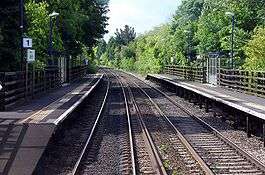Cherwell Valley line
The Cherwell Valley line is the railway line between Didcot and Banbury via Oxford. It links the Great Western Main Line and the south to the Chiltern Main Line and the Midlands. The line follows the River Cherwell for much of its route between Banbury and Oxford.
| Cherwell Valley line | |
|---|---|
 Appleford railway station in 2009 | |
| Overview | |
| Type | Heavy rail |
| System | National Rail |
| Status | Operational |
| Locale | Oxfordshire, South East England |
| Stations | 7 |
| Operation | |
| Owner | Network Rail |
| Operator(s) | CrossCountry Great Western Railway |
| Rolling stock | Class 165 "Turbo" Class 166 "Turbo Express" Class 220 "Voyager" Class 221 "Super Voyager" Class 800 "Intercity Express Train" |
| Technical | |
| Track gauge | 1,435 mm (4 ft 8 1⁄2 in) standard gauge |
| Cherwell Valley line | |||||||||||||||||||||||||||||||||||||||||||||||||||||||||||||||||||||||||||||||||||||||||||||||||||||||||||||||||||||||||||||||||||||||||||||||||||||||||||||||||||||||||||||||||||||||||||||||||||||||||||||||||||||||||||||||||||||||||||||||||||||||||||||||||||||||||||||||||||||||||||||||||||||||||||||||||||||||||||||||||||||||||||||||||||||||||||||||||||||||||||||||||||||
|---|---|---|---|---|---|---|---|---|---|---|---|---|---|---|---|---|---|---|---|---|---|---|---|---|---|---|---|---|---|---|---|---|---|---|---|---|---|---|---|---|---|---|---|---|---|---|---|---|---|---|---|---|---|---|---|---|---|---|---|---|---|---|---|---|---|---|---|---|---|---|---|---|---|---|---|---|---|---|---|---|---|---|---|---|---|---|---|---|---|---|---|---|---|---|---|---|---|---|---|---|---|---|---|---|---|---|---|---|---|---|---|---|---|---|---|---|---|---|---|---|---|---|---|---|---|---|---|---|---|---|---|---|---|---|---|---|---|---|---|---|---|---|---|---|---|---|---|---|---|---|---|---|---|---|---|---|---|---|---|---|---|---|---|---|---|---|---|---|---|---|---|---|---|---|---|---|---|---|---|---|---|---|---|---|---|---|---|---|---|---|---|---|---|---|---|---|---|---|---|---|---|---|---|---|---|---|---|---|---|---|---|---|---|---|---|---|---|---|---|---|---|---|---|---|---|---|---|---|---|---|---|---|---|---|---|---|---|---|---|---|---|---|---|---|---|---|---|---|---|---|---|---|---|---|---|---|---|---|---|---|---|---|---|---|---|---|---|---|---|---|---|---|---|---|---|---|---|---|---|---|---|---|---|---|---|---|---|---|---|---|---|---|---|---|---|---|---|---|---|---|---|---|---|---|---|---|---|---|---|---|---|---|---|---|---|---|---|---|---|---|---|---|---|---|---|---|---|---|---|---|---|---|---|---|---|---|---|---|---|---|---|---|---|---|---|---|---|---|---|---|---|---|---|---|---|---|---|---|---|---|---|---|---|---|---|---|---|---|---|---|---|---|---|
| |||||||||||||||||||||||||||||||||||||||||||||||||||||||||||||||||||||||||||||||||||||||||||||||||||||||||||||||||||||||||||||||||||||||||||||||||||||||||||||||||||||||||||||||||||||||||||||||||||||||||||||||||||||||||||||||||||||||||||||||||||||||||||||||||||||||||||||||||||||||||||||||||||||||||||||||||||||||||||||||||||||||||||||||||||||||||||||||||||||||||||||||||||||
Current and former stations served
- Banbury, formerly called Banbury Bridge Street
- Kings Sutton
- Former station at Aynho for Deddington
- Former station at Fritwell & Somerton
- Heyford, formerly called Lower Heyford
- Tackley
- Former station for Bletchington, previously called Kirtlington
- Former station at Kidlington previously called Woodstock Road
- Former halt at Wolvercot Platform
- Oxford
- Former halt at Hinksey
- Former halt at Abingdon Road
- Radley
- Former station at Abingdon Junction
- Culham, formerly called Abingdon Road
- Appleford
- Didcot Parkway, formerly called Didcot
The former station for Bletchingdon was always spelt "Bletchington", which is an alternative spelling for that village's toponym. The former halt at Wolvercote was called "Wolvercot Platform", with a deliberately different spelling of the village's name, to distinguish it from the London and North Western Railway's nearby Wolvercote Halt.
Services
Passenger services are provided by CrossCountry and Great Western Railway. GWR markets the local service between Oxford and Banbury as the Oxford Canal Line.
The line carries a large and increasing volume of freight between the Port of Southampton and the Midlands, much of it container trains operated by Freightliner.
Tilting
With the exception of the West Coast Main Line, this route was the only route on which domestic UK trains could tilt, something of which Virgin CrossCountry took advantage of, using Class 221 Super Voyagers from 2004.[1] After Virgin CrossCountry's successor CrossCountry elected to remove the tilting equipment from its Class 221s to increase reliability and reduce costs, tilt running ceased in 2008.[2]
River Thames
The line makes three crossings of the River Thames between Oxford and Didcot:
Electrification
In 1977 the Parliamentary Select Committee on Nationalised Industries recommended considering electrification of more of Britain's rail network, and by 1979 BR presented a range of options to do so by 2000.[3] Some of these options would have included the whole Cherwell Valley line and the Banbury–Birmingham section of what is now the Chiltern Main Line plus the Coventry to Leamington line.[3] The 1979–90 Conservative governments that succeeded the 1976–79 Labour government did not implement the proposal.
Under plans for the Great Western Electrification project announced in July 2009, the Cherwell Valley line was due to be electrified from Didcot as far as Oxford.[4] However, delays and cost overruns elsewhere caused this to be deferred indefinitely in 2016.[5]
References
| Wikimedia Commons has media related to Cherwell Valley Line. |
- "Debut trip for new tilting train". BBC News. 29 April 2004.
- Miles, Tony (August 2008). "Cross Country stops Tilting". Modern Railways. Vol. 65 no. 719. Shepperton: Ian Allan. p. 71. ISSN 0026-8356.
- Anonymous (Winter 1979). Railway Electrification. British Railways Board (Central Publicity Unit). pp. 0–2, 8.
- "Rail Electrification" (PDF). Britain's Transport Infrastructure. Department for Transport. July 2009. Archived from the original (PDF) on 5 August 2009.
- https://www.bbc.co.uk/news/uk-england-oxfordshire-37908735
